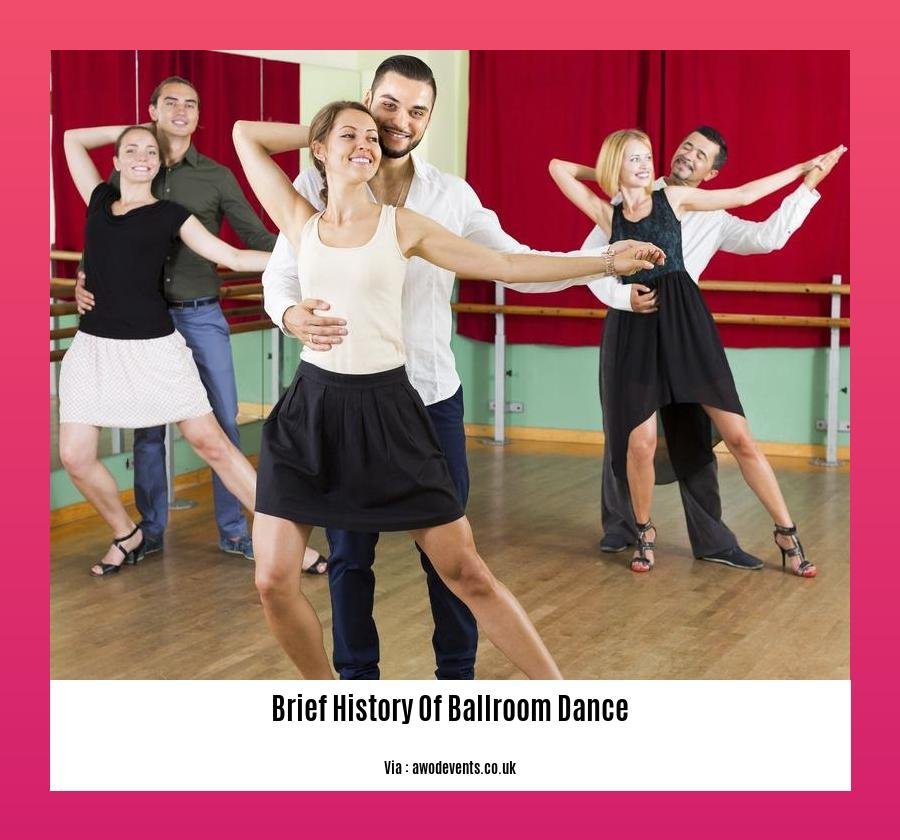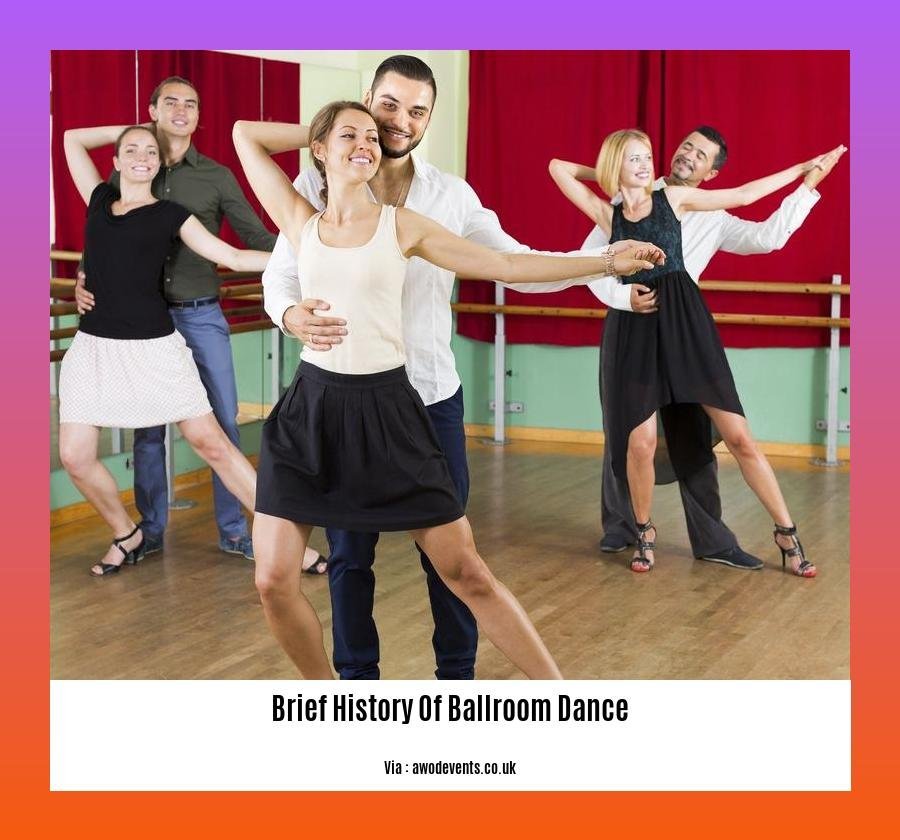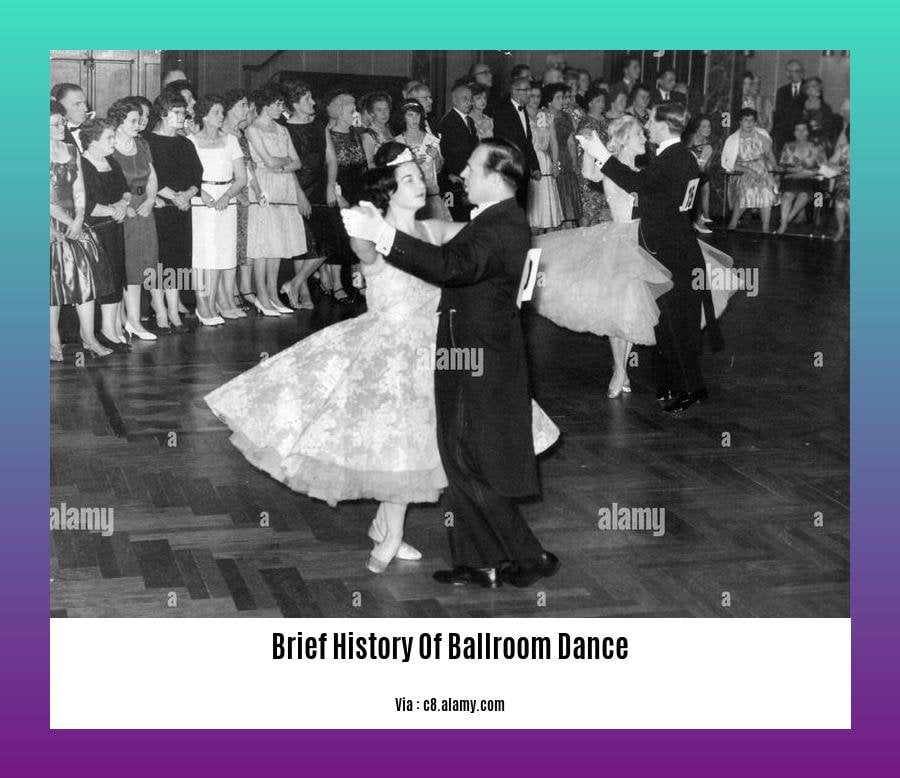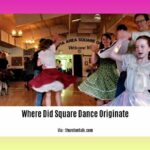Immerse yourself in the captivating history of ballroom dance as we embark on a mesmerizing journey through time. From its humble beginnings to its global recognition, discover how this elegant art form has evolved and captivated audiences for centuries. Get ready to waltz through the ages as we uncover the origins, influences, and enduring legacy of ballroom dance.
Key Takeaways:
Ballroom dance has its roots in European court dances of the 17th and 18th centuries, blending elements from folk traditions.
The Minuet dance gained popularity in 1650 when King Louis XIV of France embraced it, influencing ballroom dance in France and Europe until the late 18th century.
“Ballroom dance” originated from the Latin term “ballare,” which means “to dance,” and signifies a large room dedicated to dancing.
The term “ballroom dance” was primarily associated with the privileged classes, while folk dancing was common among the lower classes.
Brief History of Ballroom Dance


Ballroom dance, a mesmerizing blend of art, culture, and tradition, traces its roots back centuries, evolving from the courtly gatherings of Europe’s elite to the vibrant social dance floors of today. Let’s waltz through the ages, exploring the captivating history of ballroom dance.
The Courtly Origins
In the 17th and 18th centuries, European courts reverberated with the rhythm of ballroom dance. Aristocrats adorned in opulent finery glided across grand ballrooms, showcasing their grace and elegance in intricate dance patterns. These courtly dances, influenced by folk traditions, laid the foundation for the ballroom dance we know today.
The Minuet’s Reign
Among the courtly dances, the Minuet emerged as a star, captivating the French court and eventually spreading its allure across Europe. This graceful dance, characterized by its delicate steps and elegant bows, became the epitome of refinement and sophistication. King Louis XIV, the Sun King himself, was an avid patron of the Minuet, ensuring its widespread popularity.
The Birth of the Ballroom
The term “ballroom dancing” owes its origin to the Latin word “ballare,” meaning “to dance.” These grand rooms, specifically designed for dancing, became the epicenter of social gatherings, where people from all walks of life could come together and indulge in the joys of dance.
Bridging Social Classes
While ballroom dancing initially flourished among the aristocracy, it gradually transcended social boundaries. The lower classes embraced their own forms of dance, influenced by their unique cultural traditions. This fusion of styles and influences created a rich tapestry of dance forms that continue to captivate audiences worldwide.
Evolving Grace and Expression
Over the centuries, ballroom dance underwent a remarkable transformation. New dance styles emerged, reflecting the changing social and cultural norms. The waltz, with its sweeping movements and romantic flair, took Europe by storm in the 19th century. The Charleston, a lively and energetic dance, epitomized the roaring twenties. And the salsa, with its infectious Latin rhythms, continues to set dance floors ablaze today.
Ballroom dance, with its diverse styles and enduring appeal, remains an art form that transcends time and cultures. Whether you’re a seasoned dancer or simply captivated by the allure of ballroom dance, this historical journey offers a glimpse into its rich heritage and lasting legacy.
Did you know that in the brief history of English literature, the works of Shakespeare have stood the test of time and are still widely read and enjoyed today? Did you know that the brief history of Nigerian people dates back to the 15th century, when the first Portuguese explorers arrived on the coast of the country? And did you know that the brief history of music can be traced back to prehistoric times, when early humans used simple instruments to create music?
The Origin of Ballroom Dance
Ballroom dancing has crossed centuries, forming a mesmerizing dance style that continues to captivate hearts worldwide. Let’s waltz through the origins of this elegant art form:
The Aristocratic Beginning
- Ballroom dance emerged in the 17th century, taking root in the courts of Europe’s nobility.
- Elaborate social gatherings called “balls” provided a platform for aristocrats to showcase their dancing prowess, fostering camaraderie and courtship.
- Dance became an integral part of aristocratic education, considered a symbol of refinement and social grace.
Folk Dance Influence
- The foundation of ballroom dance was heavily influenced by folk traditions embraced by the lower classes.
- Lively steps, rhythmic patterns, and energetic movements from folk dances weaved their way into the ballroom, infusing it with a sense of vibrancy and joy.
- The fusion of aristocratic elegance with the vitality of folk dance created a captivating new dance style that transcended class boundaries.
The First Ballroom Dances
- The Minuet, a graceful and stately dance. It originated in France in the 17th century and quickly gained popularity throughout Europe.
- The Quadrille, a lively square dance originating in France, became a favorite at balls, allowing multiple couples to participate simultaneously.
- The Waltz, a romantic and enchanting dance, emerged in the 18th century and took Europe by storm, captivating dancers with its fluid movements and close embrace.
Key Takeaways:
Aristocratic Roots: Originated in European courts in the 17th century, ballroom dance was a symbol of refinement and grace among the nobility.
Folk Dance Influence: Drawing inspiration from folk traditions, ballroom dance incorporated lively steps and energetic movements, adding a vibrant and joyful element.
Early Dances: Pioneering dances like the Minuet, Quadrille, and Waltz played a pivotal role in shaping the foundations of ballroom dance.
Societal Impact: Ballroom dancing transcended class boundaries, becoming a popular pastime enjoyed by people from all walks of life, fostering social interaction and community.
Citations:
- Encyclopedia Britannica – Ballroom Dance
- History of Ballroom Dance – DanceFacts.net
FAQ
Q1: When did ballroom dancing originate?
A1: Ballroom dancing emerged in the late 17th century, finding its roots in the court dances of Europe’s elite.
Q2: What significant influence did the Minuet have on ballroom dance?
A2: The Minuet, originating in France around 1650, became a defining feature of ballroom dance under King Louis XIV, popularizing the art form throughout France and beyond.
Q3: Why did ballroom dancing carry a distinctive social significance?
A3: Ballroom dance initially served as an avenue for social interaction and courtship among the privileged classes, setting it apart from folk dancing prevalent among the lower classes.
Q4: How did the term “ballroom dancing” originate?
A4: The term “ballroom dancing” stems from the Latin word “ballare,” meaning “to dance,” and refers to the designated large room where these dances took place.
Q5: What was the origin of the polka in the history of ballroom dance?
A5: The polka emerged in Bohemia around 1830 and became a significant addition to the repertoire of ballroom dances.















